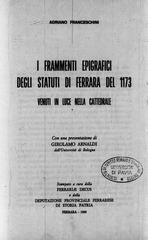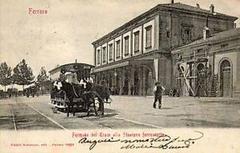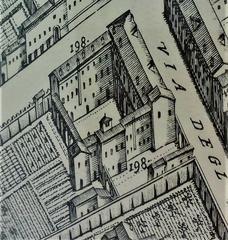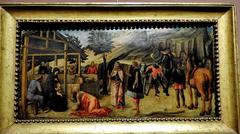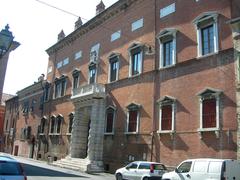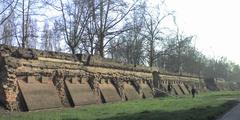Basilica of St. Francis of Assisi, Ferrara & Assisi: Visitor Guide, History, and Practical Information
Date: 04/07/2025
Introduction
The Basilica of St. Francis of Assisi in Ferrara, Italy, is a landmark that encapsulates centuries of religious devotion, architectural innovation, and cultural heritage. Originating as a modest Franciscan church in the 13th century, it later became a symbol of Renaissance splendor and Este family patronage. Today, it stands as a must-see for art, history, and architecture enthusiasts, offering free admission, accessible facilities, and a rich artistic legacy. This comprehensive guide details the basilica’s history, visitor information, and travel tips, as well as practical details for visiting its renowned counterpart in Assisi.
Table of Contents
- Introduction
- Historical Background (Ferrara)
- Visiting the Basilica in Ferrara
- Architectural & Cultural Significance (Ferrara)
- Basilica of St. Francis of Assisi in Assisi
- Frequently Asked Questions (FAQ)
- Summary & Recommendations
- References
Historical Background: Basilica of St. Francis of Assisi, Ferrara
Franciscan Origins
Founded in the early 13th century, the first Franciscan church and monastery in Ferrara reflected the order’s rapid growth and ideals of humility and service. By 1232, the Franciscans had established a modest religious community, which soon outgrew its original structure as Ferrara’s population and the order’s influence expanded (Wikipedia).
Este Family Mausoleum & Renaissance Transformation
A watershed moment arrived in the late 15th century, when the Este family—Renaissance Italy’s powerful rulers—adopted the basilica as their mausoleum. In 1494, Biagio Rossetti, Ferrara’s master architect, redesigned the church, endowing it with a striking Renaissance façade inspired by Leon Battista Alberti. The use of local terracotta and marble pilasters created a harmonious and uniquely Ferrarese aesthetic, elevating the basilica to a civic and artistic centerpiece (Italyscapes; Religiana).
Artistic Heritage
Over subsequent centuries, the basilica became a treasure trove of art and funerary monuments. Notable works include Garofalo’s 16th-century fresco “Capture of Christ” and the Baroque cenotaph of Marchese Ghiron Francesco Villa. The church features a Latin cross plan with three naves, eight chapels per side, and a luminous interior that showcases Renaissance and Baroque masterpieces (MuseoFerrara; inferrara.it).
Napoleonic Suppression & 20th-Century Changes
The Napoleonic era saw the removal of many original artworks, which were transferred to the Ferrara Pinacothek. Despite such losses, the basilica retained its grandeur and spiritual role in the community. In 1956, it was elevated to the dignity of a minor basilica by Pope Pius XII (Wikipedia IT).
Earthquakes & Restoration
The 2012 Emilia-Romagna earthquake caused significant structural damage. Ongoing restoration has since reopened most of the basilica, underscoring Ferrara’s commitment to preserving this historic site for future generations (Italyscapes).
Visiting the Basilica in Ferrara
Hours, Tickets & Accessibility
- Hours:
- Monday to Saturday: 9:00 AM – 6:00 PM
- Sundays & Holidays: 10:00 AM – 5:00 PM
- Hours may vary during special events; check the official Ferrara tourism website before your visit.
- Admission: Free entry. Guided tours require a ticket (prices vary).
- Accessibility: Wheelchair accessible, with ramps and accessible restrooms. Assistance is available upon request.
Guided Tours & Special Events
- Guided tours, available in multiple languages, offer in-depth exploration of the basilica’s history and art.
- Special events include religious ceremonies, concerts, and exhibitions—advance booking is recommended during busy periods.
- The basilica features notable acoustic properties; clapping in the center produces a remarkable echo (inferrara.it).
Travel Tips & Nearby Attractions
- Located at Via Terranuova and Via Savonarola, in the heart of Ferrara’s UNESCO-listed historic center.
- Easily reachable by foot or public transport; car parking is limited.
- Nearby: Este Castle, Palazzo dei Diamanti, Oratory of the Immaculate Conception, Schifanoia Museum, Casa Romei.
- Mornings offer the best light for photography, especially the Renaissance façade.
Architectural & Cultural Significance (Ferrara)
The basilica exemplifies the transition from Gothic to Renaissance architecture in northern Italy. Biagio Rossetti’s redesign synthesized Alberti-inspired elements with local craftsmanship, resulting in a structure both monumental and intimately tied to Ferrara’s urban identity. Inside, funerary monuments and chapels chronicle the social and cultural history of the region, while ongoing restoration ensures the basilica’s continued role as a center for worship, community, and cultural tourism (Religiana; MuseoFerrara).
Basilica of St. Francis of Assisi in Assisi: Spiritual & Artistic Importance
Pilgrimage & Franciscan Heritage
The Basilica of St. Francis of Assisi in Umbria is the final resting place of St. Francis, drawing pilgrims and art lovers worldwide. Since its consecration in 1253, it has been a center for Franciscan spirituality, peace, and interfaith dialogue (Secret Umbria; Umbria Tourism).
Artistic Masterpieces
The basilica’s Upper and Lower Churches are adorned with renowned fresco cycles by Giotto, Cimabue, Lorenzetti, and Martini, representing milestones in Western art. The site is also home to Italy’s oldest stained glass windows, adding a transcendent atmosphere to the basilica’s spiritual environment.
Symbolism & UNESCO Status
Recognized as a UNESCO World Heritage Site, the basilica is a symbol of peace, reconciliation, and universal values. It regularly hosts international interfaith events and remains a living center of worship and community engagement.
Visitor Information: Assisi
Hours & Tickets
-
Upper Basilica:
- Summer: 8:30 AM – 7:00 PM
- Winter: 8:30 AM – 6:00 PM
-
Lower Basilica:
- Summer: 6:00 AM – 7:00 PM
- Winter: 6:00 AM – 6:00 PM
-
Tomb of St. Francis:
- Weekdays: 6:00 AM – 6:00 PM (Wednesday closes at 5:30 PM)
- Holidays: 6:00 AM – 7:00 PM
- Confirm up-to-date hours on the official basilica website.
-
Admission: Free.
-
Guided Tours: Official tours from €45; audio guides around €6. Advance booking is recommended (Veronika’s Adventure; The Geographical Cure).
Dress Code & Etiquette
- Modest attire (shoulders and knees covered) required; coverings provided if necessary.
- Silence is expected inside.
- Photography permitted without flash in most areas, but some sections prohibit it (My Catholic Pilgrimages).
Accessibility & Amenities
- Partial wheelchair accessibility; some areas have steps or uneven flooring.
- On-site restrooms, cloakrooms, museum, and visitor center are available.
Special Events
- The annual Feast of St. Francis (October 4th) is the basilica’s key religious celebration, attracting large crowds.
- The basilica may close to tourists during major events—check schedules in advance (Vagrants of the World).
Nearby Assisi Historical Sites
- Rocca Maggiore Fortress
- Basilica di Santa Chiara
- Santa Maria degli Angeli (Porziuncola)
- San Damiano & Rivotorto
Preservation & UNESCO World Heritage
Both the Ferrara and Assisi basilicas are recognized for their outstanding universal value. Ongoing restoration and preservation efforts—especially following the 1997 earthquake in Assisi and the 2012 earthquake in Ferrara—demonstrate the commitment to safeguarding these monuments for future generations (Audiala; Italia.it).
Frequently Asked Questions (FAQ)
Q: What are the Ferrara basilica’s visiting hours?
A: Monday–Saturday, 9:00 AM–6:00 PM; Sunday and holidays, 10:00 AM–5:00 PM.
Q: What are the Assisi basilica’s visiting hours?
A: Vary by season and church area—see Visitor Information above.
Q: Is entry free?
A: Yes, for both basilicas. Guided tours may require a fee.
Q: Are the basilicas wheelchair accessible?
A: Ferrara: fully accessible. Assisi: partially accessible; contact in advance for details.
Q: Can I take photographs?
A: Permitted without flash in most areas, but respect posted restrictions.
Q: Are guided tours available?
A: Yes, in both basilicas, with advance booking recommended.
Summary & Practical Recommendations
The Basilica of St. Francis of Assisi in Ferrara is a masterpiece of Italian Renaissance architecture and a repository of art and history, offering free entry, accessible facilities, and a central location among Ferrara’s top attractions. Its Assisi namesake is a global pilgrimage site, renowned for its spiritual importance and unmatched frescoes. Plan your visit by checking official websites for current hours and events, booking guided tours for deeper insight, and following visitor etiquette to respect these sacred spaces.
For an enriched experience, download travel apps such as Audiala, explore related articles, and connect with local tourism resources for updates and recommendations.
References
- Wikipedia: San Francesco, Ferrara
- Wikipedia IT: Chiesa di San Francesco (Ferrara)
- Italyscapes: Church of San Francesco Ferrara
- inferrara.it: Basilica di San Francesco
- MuseoFerrara: Basilica di San Francesco
- Religiana: Chiesa di San Francesco Ferrara
- Audiala: Basilica of San Francesco d’Assisi, Assisi
- Secret Umbria: Basilica of Saint Francis
- Umbria Tourism: Basilica of Saint Francis
- The Geographical Cure: Guide to the Basilica of St. Francis of Assisi
- Veronika’s Adventure: Basilica of St. Francis of Assisi Tour
- My Catholic Pilgrimages: Pilgrimage to Assisi, Italy
- Vagrants of the World: Visiting Assisi
- Italia.it: Basilica of St. Francis
